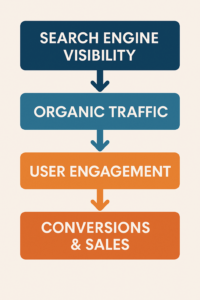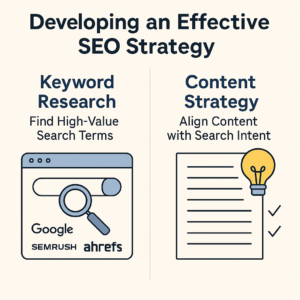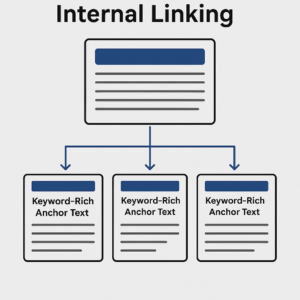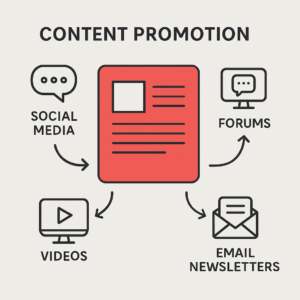Before diving into the how, it’s important to understand why SEO matters. Optimizing your website for SEO is crucial for increasing online visibility, driving organic search traffic, and outperforming competitors in search engine results. Higher rankings on Google help potential customers discover your business, boosting website visits, brand trust, and engagement. A solid SEO strategy enhances user experience and leads to more conversions, sales, and long-term growth.

Define SEO Goals and Understand Your Audience
Start your SEO journey by establishing clear, measurable goals aligned with your business objectives—whether it’s increasing organic traffic, ranking higher for competitive keywords, or boosting online conversions. Equally important is understanding your target audience’s search behavior, pain points, and intent. This foundational step ensures your SEO strategy attracts the right users and delivers value.
Conduct a Full Website SEO Audit
A detailed website audit is essential to uncover technical issues and content gaps. Analyze your site’s on-page SEO (meta tags, headers, keyword usage), technical SEO (site speed, mobile responsiveness, crawl errors), content relevance, and backlink profile. Identifying these issues early creates a roadmap for measurable SEO improvements.
Keyword Research: Find High-Value Search Terms
Start with in-depth keyword research to identify high-value terms your audience actively searches for. Use tools like Google Keyword Planner, Semrush, or Ahrefs to uncover search volume, competition, and user intent. Focus on a mix of short-tail and long-tail keywords that align with your niche and business goals.
Content Strategy: Align Content with Search Intent
Build a content strategy that targets these keywords with purpose. Create fresh, authoritative content that addresses your audience’s questions and needs. Don’t forget to update and optimize existing pages to reflect current trends, keyword opportunities, and SEO best practices. Quality content is key to ranking well and keeping users engaged.

Optimize Title Tags for Click-Through and Relevance
Create unique, keyword-rich title tags for each page. Make sure they accurately reflect the content and include your primary keyword near the beginning. Compelling titles not only improve search rankings but also increase click-through rates from search engine results pages (SERPs).
Write Keyword-Optimized Meta Descriptions
Meta descriptions should be concise (under 160 characters), include your main keyword, and clearly explain what users can expect on the page. While not a direct ranking factor, they heavily influence user click behavior and page visibility in SERPs.
Structure Content Using SEO-Friendly Headers
Use a clear heading hierarchy (H1, H2, H3) to organize your content logically. Include relevant keywords naturally in headers to signal page structure and topic relevance to search engines, and to make content easier to scan for readers.
Optimize Content for Keywords and User Value
Your content should be original, informative, and aligned with user intent. Naturally integrate primary and secondary keywords into headings, body text, and image alt text. Use clear formatting—like bullet points and short paragraphs—to improve readability. High-quality content that solves problems increases time on page, lowers bounce rates, and earns backlinks organically.

Strengthen Internal Linking for SEO and UX
Use contextual internal links to guide visitors to related pages on your site. This enhances user experience and helps search engines understand site structure and content relevance. Anchor text should include relevant keywords and point to pages that add value or support conversion goals.
Improve Website Speed for Better Rankings and UX
Site speed is a direct ranking factor and a key user experience signal. Optimize image sizes, enable browser caching, use a content delivery network (CDN), and minimize server response times. Faster websites reduce bounce rates and increase time on site—both valuable for SEO.
Ensure Mobile Optimization with Responsive Design
Google’s mobile-first indexing means your site must be fully functional and user-friendly on mobile devices.
Responsive Design: Use flexible layouts that adapt to all screen sizes.
Mobile Usability: Make navigation intuitive, with fast-loading pages and easy-to-tap buttons and links.
Mobile-First Indexing: Ensure mobile versions include the same high-quality content, metadata, and structured data as desktop.
Fix Technical SEO Errors for Crawlability and Indexing
Identify and correct common technical issues that prevent your site from ranking.
Broken Links: Regularly audit and fix 404 errors to maintain authority and user trust.
Duplicate Content: Use canonical tags or rewrite content to avoid dilution.
Crawl Errors: Monitor crawl stats in Google Search Console and fix pages blocked by robots.txt, 500 errors, or misconfigured redirects.
Earn High-Quality Backlinks from Authoritative Sources
A strong backlink profile signals trust and authority to search engines. Focus on gaining backlinks from high-domain-authority (DA) websites in your niche.
Industry-Relevant Sources: Prioritize backlinks from websites that are topically aligned with your content.
Strategic Outreach: Develop share-worthy content and pitch it to influencers, bloggers, and journalists. Use personalized outreach to increase success rates.
Guest Posting: Contribute valuable articles to well-respected industry blogs. Include keyword-rich anchor text that links back to relevant pages on your site.
Promote Content to Boost Visibility and Link Acquisition
Use content promotion to expand reach and earn natural backlinks.
Share content on platforms like LinkedIn, Twitter, and industry forums.
Repurpose blog posts into videos, infographics, or podcasts to maximize exposure.
Collaborate with influencers or partners for cross-promotion opportunities.

Monitor Performance with SEO Tools
Use platforms like Google Analytics, Google Search Console, and Ahrefs to track your website’s SEO performance. Focus on key metrics such as organic traffic, bounce rate, average session duration, crawl errors, and index status to assess site health and user engagement.
Generate Actionable Monthly SEO Reports
Compile detailed monthly reports to guide data-driven decisions.
Traffic Trends: Evaluate traffic patterns to identify high-performing pages and optimize underperformers.
Keyword Rankings: Monitor keyword position changes and highlight opportunities to improve ranking for strategic terms.
Conversion Metrics: Track bounce rates, CTRs, and goal completions to measure the real ROI of your SEO strategy.
Adjust Strategy Based on Data and Algorithm Updates
SEO is dynamic—continually adapt your approach to reflect new data and Google’s algorithm changes. Implement A/B tests, content refreshes, and technical fixes based on insights. Staying agile ensures long-term search visibility and growth.
Effective SEO isn’t a one-and-done task—it’s a continuous process that evolves with search engine algorithms, user behavior, and market trends. By consistently applying on-page, off-page, and technical SEO best practices, you can increase your website’s visibility, drive high-quality organic traffic, and build long-term brand authority.
Whether you’re just starting or refining an existing strategy, staying proactive and informed is key. Ready to elevate your site’s performance and rankings? Contact us today for a custom SEO plan designed to deliver real results. Let’s build your online growth together.